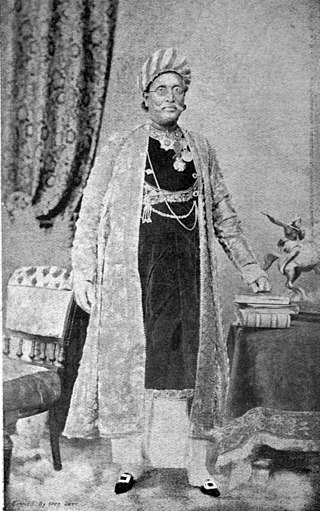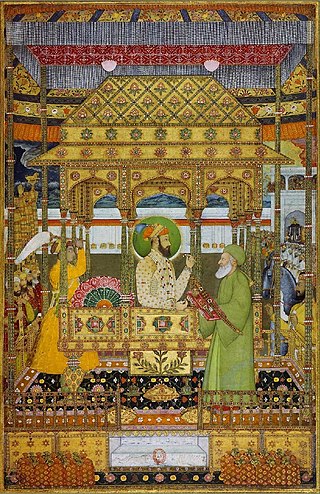
Sir Syed Ahmad Khan, also spelled Sayyid Ahmad Khan, was an Indian Muslim reformer, philosopher, and educationist in nineteenth-century British India.
Mirza is a multi-ethnic name of Persian language origin. It is used as a surname or prefix to identify patriarchal lineage. It is derived from the term Mirzadeh.

Rohillas are a community of Pashtun heritage, historically found in Rohilkhand, a region in the state of Uttar Pradesh, India. It forms the largest Pashtun diaspora community in India, and has given its name to the Rohilkhand region. The Rohilla military chiefs settled in this region of northern India in the 1720s, the first of whom was Ali Mohammed Khan.

Nawab Bahadur QaziAbdul Latif was a Bengali Muslim aristocrat, educator and social worker. His title, Nawab was awarded by the British in 1880. He was one of the first Muslims in 19th-century India to embrace the idea of modernisation.

Nawab Mohsin-ul-Mulk, Munir Nawaz Jang, also known as Syed Mir Mehdi Ali, was an Indian Muslim politician. He was a close friend of Syed Ahmed Khan, was involved in the Aligarh Movement and was one of the founders of the All India Muslim League in 1906.

Nawab Wiqar-ul-Mulk was a British Indian Muslim politician and one of the founders of All India Muslim League. He was also the maternal uncle of Sir Ziauddin Ahmed, a mathematician and proponent of the Aligarh Movement.

SirZiauddin Ahmad was an Indian mathematician, parliamentarian, logician, natural philosopher, politician, political theorist, educationist and a scholar. He was a member of the Aligarh Movement and was a professor, principal of MAO College, first pro vice-chancellor, vice chancellor and rector of Aligarh Muslim University, India.

Muhammad Saleh Kamboh Lahori was a noted Punjabi Muslim calligraphist and official biographer of Emperor Shah Jahan and the teacher of Mughal Emperor Aurangzeb. Though a widely read person, little is known of the life of Muhammad Saleh Kamboh other than the works he composed. He was son of Mir Abdu-lla, Mushkin Kalam, whose title shows him to also have been a fine writer. He is believed to be younger brother of Inayat-Allah Kamboh and worked as a Shahi Dewan (Minister) with the governor of Lahore. He held the title of Sipahsalar.

Azimabad was the name of modern-day Patna during the eighteenth century, prior to the British Raj. Today, Patna is the capital of Bihar, a state in North India. In ancient times, Patna was known as Pataliputra. This was the capital of the Maurya and Gupta Empires.

Shahrullah Kamboh, better known as Shahbaz Khan Kamboh, was a Punjabi Muslim and one of the leading generals of Mughal emperor Akbar. He participated in some of the most difficult expeditions of Akbar and annexed numerous territories to the empire. The Mughal officials boasted that he conquered countries ten times the size of Deccan. He was too orthodox a Sunni Muslim for Akbar's taste, but not only was he tolerated but also was greatly valued. He was named "Mang Khan" by the people of Lahore meaning "ask the Khan and it will be done" In Punjabi due to his legendary generosity. The very first 'guzar' in Lahore Fort was named Guzar Shahbaz Khan known locally as Guzar Mang Khan.
Sir Muhammad Yamin Khan CIE was a barrister-at-law, statesman and politician in the period before the partition of India. Khan served as a parliamentarian and one of the senior most members of the All India Muslim League.

Nawab Khair Andesh Khan Kamboh, born Abu Muhammed Khan Kamboh was a son of Nawab Muhabbat Khan. He was the most noted member of the illustrious family of the Kamboh Nawabs of Meerut and flourished during the reign of Shah Jehan and Aurangzeb.
Nawab Khair Andesh Khan Sani was son of Muhammed Fazel Khan and grandson of Nawab Khair Andesh Khan, and belonged the illustrious family of the Kamboh Nawabs of Meerut. His original name was Muhammad Masih. He held a manasab of five thousand and the title of Nek Andesh Khan under Mughal Emperor Aurangzeb. Later under Emperor Bahadur Shah, he held six thousand mansab and received a title of Khair Andesh Khan. Khair Andesh Khan Sani built Khair Nagar in Bareilly and also built one Idgah, one Mubarak palace and many other buildings in Khair Nagar. He also waged war against king of Bundelkhand and reduced him to subjugation. His son was given the title of Nek Andesh Khan and a big fief or Jagir in Bareilly. His one brother Nawab Khairiyat Andesh Khan held a mansab of five thousand and remained governor of Kashmir where he constructed a Bazar known as Nawab Bazar. His second brother also got the title of Kheir Andesh Khan Salas during the reign of emperor Ahmed Shah Durani and also held the governorship of Kashmir.

Jamal Khwaja was an Indian philosopher.

Abdul Majeed Khwaja was an Indian lawyer, educationist, social reformer and freedom fighter from Aligarh. In 1920, he along with others founded Jamia Millia Islamia and later served its vice chancellor and chancellor.
The Aligarh Movement was the push to establish a modern system of Western-style scientific education for the Muslim population of British India, during the later decades of the 19th century. The movement's name derives from the fact that its core and origins lay in the city of Aligarh in Central India and, in particular, with the foundation of the Muhammadan Anglo-Oriental College in 1875. The founder of the oriental college, and the other educational institutions that developed from it, was Sir Syed Ahmed Khan. He became the leading light of the wider Aligarh Movement.

Native speakers of Urdu are spread across South Asia. The vast majority of them are Muslims of the Hindi–Urdu Belt of northern India, followed by the Deccani people of the Deccan plateau in south-central India, most of the Muhajir people of Pakistan, Muslims in the Terai of Nepal, and Muslims of Old Dhaka in Bangladesh. The historical centres of Urdu speakers include Delhi and Lucknow. Another defunct variety of the language was historically spoken in Lahore for centuries before the name "Urdu" first began to appear. However, little is known about this defunct Lahori variety as it has not been spoken for centuries.

Shāh Nūrī Bengālī was an 18th-century Bengali Islamic scholar and author from Dhaka. He is best known for his magnum opus, Kibrīt-e-Aḥmar, which was written in the Persian language.














